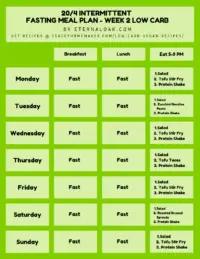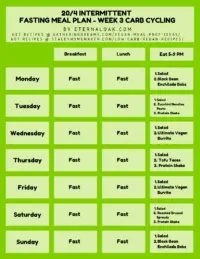Why 20/4 intermittent fasting?
Have you struggling to get results through calorie counting are want something new?
Heard about the warrior diet or 20/4 and want to give it a go?
Does less meal prep sound like a dream?
Do you love to eat till your stomach groans in delight?
Then read on discover how 20/4 might be right for you…
Table of Contents
What is 20/4 Intermittent Fasting (AKA the Warrior Diet)?
The 20/4 diet was originally called the Warrior diet and was invented by Ori Hofmekler.
He even wrote an entire book on the subject called, of course, The Warrior Diet.
Ori based it off his research of ancient Roman soldiers who would train, march, and fight during the day then feast on a meal of whole grains and protein at night.
After trying it himself, getting ripped, and boosting his energy through the roof, Ori was sold.
Originally invented back in the 1990s, Ori continues to practice it today as a longevity tool.
You can watch Abel James, the Fat Burning man, interview Ori all about it here.
How to Do 20:4 Intermittent Fasting like a Warrior
What do you eat on 20:4 Intermittent Fasting?
Yes, you can eat during the 20 hours of fasting according to Ori. Here’s what you can eat during the 20 hours:
- Raw fruits
- Raw vegetables
- Vegetable juices
- Yogurt or cottage cheese
- Clear broth
- Hardboiled eggs
During the 4 hour eating window do the following:
- Eat a salad first
- Eat one or more large meals that include
- Beans
- Whole, unprocessed grain – Whole Corn, Wild Rice, Wheat Berries or Steel Cut Oats
- Cooked vegetables
Foods to avoid
Ori recommends avoiding the following foods during either the fast or the big meal:
- Processed meats
- Refined carbohydrates (e.g. wheat flour, corn meal, quick cook oats)
- Fruit juice
- Candy
- Chips
- Diet soda or artificial sweeteners
The easiest way to do 20:4 fasting is to eat nothing but coffee, tea, or water for 20 hours then eat one or two meals during the four hour window.
If following Ori Hofmekler’s Warrior diet you will do the following three phases:
Phase 1 – Detox
Week one focuses on detoxing and learning the 20:4 pattern.
For the 20 hour fast eat from the list above or eat nothing at all.
For the 4 hour eating window, always start with a salad using oil based dressing.
After you finish the salad eat one or two meals. Make sure to include beans, whole grains (e.g. whole corn, steel cut oats, wild rice, wheat berries). White rice, corn meal, ground whole wheat, and quick cook oats are all refined. You can’t eat them.
Phase 2 – High Fat
Week two focuses on healthy fats.
Follow the 20 hour fast as above.
Again, start the 4 hour eating window with a salad with oil-based dressing. Then eat lean protein and cooked vegetables until you are full. Eat at least one handful of nuts.
No grains or starches at all during this phase, even whole grains (i.e. no beans, no corn, no rice, no potatoes). Just eat protein and vegetables and a few nuts till full.
Don’t eat just nuts either.
Phase 3 – Carb/Protein Cycling
Week three uses carb/protein cycling. One day you’ll focus on carbs then next day high protein/low card. You’ll go back and forth like that to finish the week.
Again, start with a salad during the 4 hour eating window.
On high protein days Ori recommends 8-16 ounces of lean animal protein. See the vegan version below. No starches on high protein days but you can eat a piece of fruit for dessert.
On high carb days make whole cooked corn, potatoes, wild rice, wheat berries or beans the main items. Add lean meat or veggie burgers if you want but keep the serving small.
Warrior’s Rule of Thumb – Always start with a salad during the 4 hour eating window of the 20:4.
What to do after Phase 3?
After Phase 3 follow Ori’s advice and start the 3 phases over again and repeat until you get the results you desire.
How to Do 20:4 As a Vegan
Protein is not defined as meat. You can easily do a vegan version of the 20:4 using plant proteins. Use these guidelines to complete a vegan 20:4:
- Vegan Phase I – eat any plant proteins you desire. Whole food sources like beans are preferred in this phase. All whole grains come with protein.
- Vegan Phase II – During this phase grains and starches must be excluded but you must still eat protein to keep to Ori’s version of the diet. Again, protein means protein not meat.
- Vegan Phase III –
- During the High Carb Phase all vegan protein sources work
- During the High Protein phase limit your protein to powders and pure sources of protein.
During Phase II and the high protein part of Phase III you can’t eat grains or starch. That means refined protein products only.
- Pea protein
- Wheat protein
- Brown rice protein
Do not use fake meats during Phase II and III. Almost all of them contain some kind of starch or grain.
Is that healthy? It’s debatable but who cares. To follow the Warrior diet as described this is the path to take.
Try the 3 phases first, check your results and see how you feel. Then after reassess and experiment.
20:4 Intermittent Fasting Meal Plan PDFs
Vegan 20/4 Week 1 – Detox Meal Plan
Vegan 20/4 Week 2 – Low Carb Meal Plan
Vegan 20/4 Week 3 – Carb Cycling Meal Plan
Benefits of 20:4 Intermittent Fasting
- Weight loss and fat reduction (1). Note that even in that study they recommended going beyond 8 weeks of intermittent fasting and that 30% calorie reduction leads to fat loss just as easily. See this study for a review of different fasting methods (2).
- Reduces risk of Alzheimer’s disease (3)
- Reduced inflammation (which leads to better memory and learning) (4)
- Improved blood sugar control (5). Please note that another study found hypoglycemia (low blood sugar) due to fasting (6). Fasting must be done with your doctor’s help if you have blood sugar issues!
- More Benefits – See the full list of benefits on intermittent fasting at our 30 Day Water Fasting article. The list above just covers research relating to 20:4. There’s a ton of fasting research out there!
Downsides of 20:4 Intermittent Fasting
- It’s hard!
- It can be dangerous for some
- Children
- Pregnant
- Diabetes
- Eating disorders
- May not be better than normal calorie restricted diets (7)
- Could have side effects (7). One study of 9 women reported the following side effects below. Note that this study was done using alternate day fasting, not 20:4. These items were taken from their food diaries.
- Increased hunger
- Bad mood
- Irritability
- Difficulty concentrating
- Increased Fatigue
- Over-eating on normal eating days
Facebook Support Groups for Intermittent Fasting
Join these groups for support while fasting. Remember, first support others before asking for support in return.
- Intermittent Fasting
- Intermittent Fasting For Men
- Intermittent Fasting
- Intermittent Fasting Women 16:8
- 16:8 18:6 20:4 Intermittent Fasting Support
- Intermittent Fasting 20:4,18:6,16:8,5:2 and beyond(women only)
- Fasting for Fat Loss
20/4 Intermittent Fasting Success Stories
Janielle Wright lose 65 pounds on 6 months using 20/4 (Read her story at NBC News).
Watch these other 20/4 Before and After Success Stories.
And here’s one using One Meal a Day (OMAD). Not exactly 20/4 but essentially the same thing.
20/4 Frequently Asked Questions
Does 20/4 Fasting Get You Into Ketosis?
Yes during Phase 2, no during Phase 1 and Phase 3. It takes 2-4 days of eating less than 50 grams of carbs a day to get into ketosis (8). The 20 hour fast is not long enough to get into full ketosis especially if you are eating from the approved list of foods during this time.
How can I ease intermittent fasting?
- Stay Busy – Plan to do most of your work during fasting days. You’ll have more energy than you expect which in turn creates more time. Get some sh*t done!
- Stay hydrated – Don’t confuse thirst with hunger. Get a gallon of water and drink it all day. Keep it heavily iced. A cold stomach dulls hunger
- Grab a coffee, diet soda, or tea. Make it cold or hot. Caffeine and cold dull hunger and keep you motivated.
- Get help – Join fasting facebook groups. Find friends. Help them when they need it and ask for help when you need it.
- Get distracted – watch TV, scroll instagram, keep your mind busy. Better yet, go for a long hike/bike/paddle where you don’t have access to food or to food advertising.
- Use Guided Meditations – Try these free meditations on youtube for controlling hunger. Number 2 is 8 hours long!!!
What Should I eat after fasting for 20 hours?
Start with a salad then eat according to the guidelines above.
What can you drink during intermittent fasting?
Stick to non-caloric beverages – tea, black coffee, and water. You can drink diet sodas but Ori doesn’t recommend artificial sweeteners if you are doing the Warrior diet version of 20/4.
How much weight can you lose with intermittent fasting?
See the example success stories above. On average, intermittent fasters lose 1-2 pounds a week or about 6 to 9 pounds a month.
How do I boost results from intermittent fasting?
Do it for 6 months and be consistent. There’s no silver bullet. Going fast can hurt you physically. Use the support groups and the meditations above to stay motivated.
The best success stories come from those that stuck with the plan for 4-6 months.
What is the most effective form of intermittent fasting?
The one you can stick to for 4-6 months.
Can you drink alcohol on intermittent fasting?
Yes but there can be complications. I’ll let Thomas DeLauer explain.
Key points:
- Alcohol has 7 calories per gram. It breaks a fast.
- Alcohol is technically a poison from the body’s view. It will stop burning everything else and focus on getting rid of alcohol first.
- Thomas gets into the details so watch below!
Like this article? Share this pin!!!!



